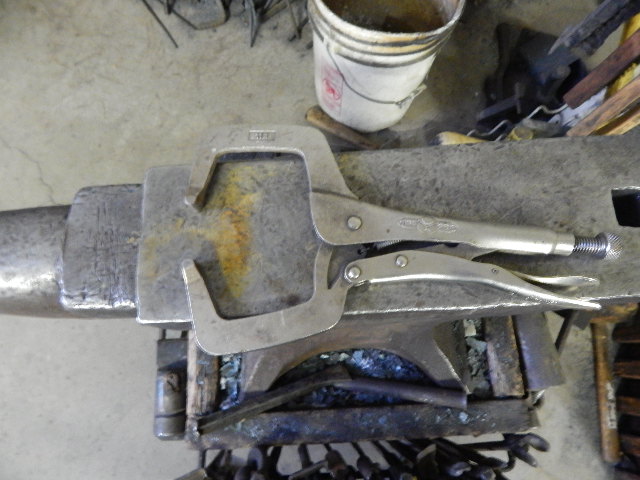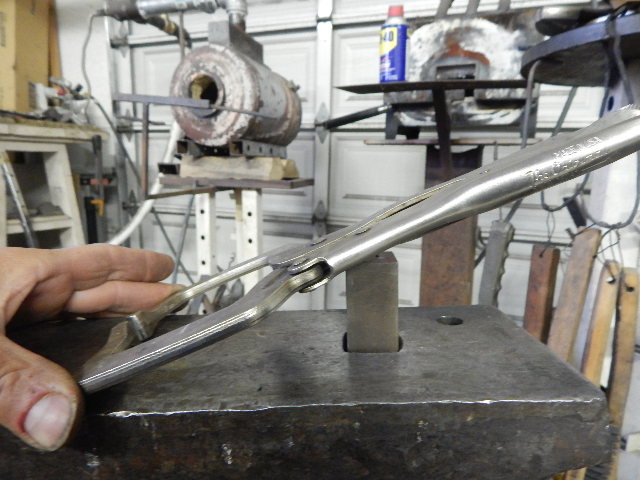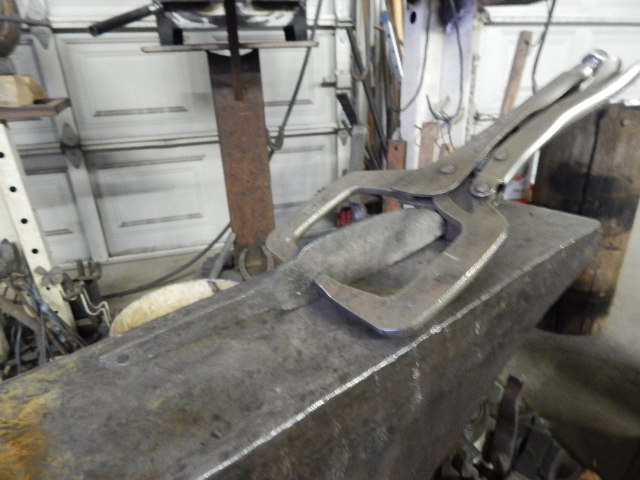Howdy everyone,
I would like to try a brute de forge knife, however, I am without a post vise. Is there a way to forge the guard in without securing the blade in a vise? I would be glad to know if there is an alternative recommended technique.
Many thanks,
Tim
When I started doing brut de forge, i didn´t have vise, so I tried in many other ways... and i can tell you that there is no other way. Any other thing that you will try, Will make you feel frustrated because the result will not be adequate.
Good luck, and sorry for my english!
Guillermo.
Thanks for the advice, Guillermo! I'll try to get a vise soon. I really admire your work with this style of knife.
|quoted:
Howdy everyone,
I would like to try a brute de forge knife, however, I am without a post vise. Is there a way to forge the guard in without securing the blade in a vise? I would be glad to know if there is an alternative recommended technique.
Many thanks,
Tim
Can you show us an example of what you're going for?
Timothy,
Any stout vise secured to a welding table or solid work bench will work. It needs to be close to the forge, so you can keep the guard area hot while forging. Some use a Oxy/Acet torch to keep constant heat concentrated on the guard. It also helps to place 4X4 under the blade steel to prevent the steel from slipping through the vise while striking it.
Best of Luck!
Bob
Timothy, that was a good question. I also agree with Guillermo's reply completely.
I often use a well supplied blacksmith shop as my model for tool choices. Vises are in just about all blacksmith shops. Two or three usually. I like at least one large one for hot work and a couple or more lighter ones for filing or portability. They sometimes can be hard to find but once you do they tend to last a long time. Care and maintenance is important even for a vise.
A "brut de forge" style knife, whether a Keeslar design, or another forged finish knife will carry the mark of the smith in the sense that even though it's a knife, it was made by a blacksmith. In my opinion, it would be great to take an actual blacksmith course and get some training on hammer finishing so that the maker can do a better job. Hammer marks alone is not a sign of good smithing. An experienced blacksmith can smooth it out pretty well and his goal is to planish the piece and minimize any hammer marks. It's the ferrous oxide color and it's associated texture that is left that should be emphasized instead of deep hammer marks. Of course, it really depends on the individual look of the piece.
Necessity is the mother of invention, or so I am told. There might be another way, but as of yet, we do not know what that is.
Now, I have never made one of these Brut de Forge blades, but I have watched Joe Keeslar's video of the process.
If I were to try this without a post vice, I would have to rig up something to hold the blade stable, support the spine, and allow me to work the guard area. Let's just say I were to try this horizontally, rather than vertically.
I would probably take a vice-grip clamp like this:
Then I would take a piece of solid square bar that was slightly larger than my hardy hole and forge it to fit through and wedge in place.
(Being that I don't have that available, I will demonstrate using a piece of plain square bar for now.) Once I got that forged and fit to the hardy hole, I would slope the top and weld the clamp to it, like this:
That way I could clamp the knife, spine down, on the anvil with the end that will become the point up against the hardy post. I could then hammer the guard out on the horizontal.
You might want to modify that clamp by adding a couple pieces of flat stock to the clamp ends to provide a non-marring surface at the clamp points.
I think it is worth a try.
Joshua States
www.dosgatosforge.com
https://www.youtube.com/channel/UCdJMFMqnbLYqv965xd64vYg
https://www.facebook.com/dos.gatos.71
Also on Instagram and Facebook as J.States Bladesmith
“So I'm lightin' out for the territory, ahead of the scared and the weak and the mean spirited, because Aunt Sally is fixin’ to adopt me and civilize me, and I can't stand it. I've been there before.â€
Many thanks for all the advice, everybody. It is, in fact, the Keesler style that I would like to try. I have an extra small bech vise that I may may be able to rig up a suitable stand for, until I can procure a blacksmith's post vise. Joshua, your method also is certainly worth a try, and I thank you for the detailed explanation and pictures. There is a blacksmith not too far from me. Hopefully arrangements can be made to have some instruction on hammer finishing. All in all, I'm glad the world of bladesmithing is vast enough to offer seemingly endless projects, and I'm equally glad that the generosity of ABS members in the sharing of knowledge is more than enough to match it. Thanks fellas!




